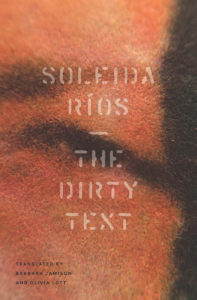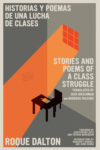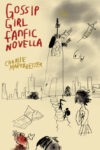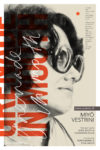 [Kenning Editions; 2018]
[Kenning Editions; 2018]
Tr. from the Spanish by Barbara Jamison and Olivia Lott
Here is a book that will put you to sleep, and not out of boredom. In this collection of dreams, the lulling rhythms and enigmatic sense of Soleida Ríos’ prose tug the conscious mind toward hypnagogia. Reading it over several nights just before bed, I found my own dreams becoming more vivid, nuanced. The aftereffects persisted for a week at least. Given the suggestibility of our subconscious (the mere desire to dream, voiced like a prayer before sleep, can help solidify one’s memories upon waking), I don’t doubt that The Dirty Text exerted an influence. The mechanisms of that influence are not what you’d expect.
The collection exhibits few of the lingual pyrotechnics associated with surrealism as “pure automatism of thought,” per Breton’s definition. It is remarkable instead for its matter-of-factness. To what extent this may be a byproduct of translation I cannot evaluate, as unfortunately I do not speak or read Spanish (those who can will no doubt appreciate Kenning’s bilingual edition). For this reason, I treat the translation on its own terms, as just another version, in the Borgesian sense, of El texto sucio. The friction between Ríos/Jamison/Lott’s flatness of tone, almost that of reportage, and the eerie “Places” and “Someones” inhabiting these pages, generates a static charge, stands the nape hairs on end. Dreams take on the same weight as waking life, which elevates, democratizes them. Cuba may be their casual setting but it’s a Cuba stripped of exoticism. “Obscene, Transparent,” for example, with its theatrical staging that returns the dead to life, its doll and wine archetypes, its condensation of femininity, wealth, jealousy, and suspicion into the symbol of a “bright red purse,” could be describing anyone’s dream:
Enter L., a doll-like girl.
Enter my mother, alive again.
Enter my sister Olivia and my Uncle Pepe, too.
L. sets a bright red purse on the table. My family wants its shine, to scratch the purse and take away its shine. They ask L. They convince her.
L. doesn’t look happy, and neither do I. This insistence with L. and her purse annoys me.
The purse is on the table, now deprived of its glossy finish.
One of my family members raises a glass of wine, red, shining, transparent.
Kristin Dykstra’s afterword makes much of the book’s genre slipperiness, the dirtiness alluded to in the title. One could just as easily call The Dirty Text a novelized dream diary, or a museum of artifacts excavated from slumber, each with its own plaque. What these stories, prose poems, or plays (let’s take our cue from the title, call them texts) recall to me most, however, is the intimacy of recounting one’s dreams over breakfast. They assume a sympathetic ear. I prefer to say that Ríos develops the dream as a genre to itself — a real fiction, a fictional real. Like entries in a journal, each text concludes with a date. But do these historical markers refer to the night the dream was dreamt, or the day of its recounting/composition? Some texts offer a place name as well — the location of the dream, or the bed? Ríos does not, however, arrange texts chronologically, but in order to form an arc that doubles back on itself, with the opening text returning to close the collection. Likewise, several texts are dated twice, years apart in some cases, as if to indicate a recurring dream, or when Ríos has spliced together separate dreams to illuminate some common theme or symbol. Footnotes, decidedly unacademic, interject from time to time. As likely to import details from other dreams as from waking life, they smudge rather than buttress the distinction. A footnote to “City,” for instance, informs us:
Almost two years later I see this: the Serpent I knew could show up at any moment was to appear on October 9 (we’ll call him Abel) and one of his most irrational obsessions, to me, was hunting and killing ants . . . Ants, he says, will be the first to surround his dead body. And another thing: the Serpent can be mesmerized by music, he has or had, or would have wanted to have his own musical instrument, a guitar.
Abel’s significance here derives from his symbolic form as Serpent, his charmable aspect. His ant-killing obsession only makes sense from the standpoint of the id. The outer world, from which this commentary at first glance appears to issue, takes no precedence, is not the yardstick by which Ríos measures the dreamworld. The two worlds interpret and interpenetrate each other, collapsing the hierarchy implied by such prefixed terms as subconscious, unconscious.
To render the banal bizarreries of dream logic, Ríos wields an idiosyncratic syntax. The following paragraph from “I Gathered Limes” exhibits many of the techniques at play:
Few, but beautiful, green and plump. Five or six unusually large limes, strangely hanging in a bunch from a single fragile stem. We were already leaving. It was when we were heading out after a quick stop over. We went into a house. I don’t know why, or who or what we wanted to see. Among those of us who were leaving, someone was in charge. On our way, I notice a small cardboard box in a corner outside the house. I went over to empty it in a hurry. There were black beans, rice and a sort of colorless powder. I emptied it into another container, or against a wall. You could see the colorless powder at the bottom, as it spills and spreads. I put the limes in the empty cardboard box and someone, not The One In Charge, objected to what I did. I was pleased.
Sentence fragments render the flashes of a dream salvaged from waking censorship. As indicated by capitals, an authority figure is identified by their function treated as a proper noun. A peppering of “ors” not only captures the vague, shifting identities of dream-objects, but establishes the dreamer, improbably, as a detached observer wary of mispresenting details by resorting to guesswork. Is the “container” in fact a container or a “wall”? The “or” precludes neither option, mirroring the instability of proportion commonly experienced in dreams. But if the techniques so far elaborated subtly embody dream logic, tense shifts actively defamiliarize or make strange, to borrow the terminology of Russian formalism. They mark the reconstructed nature of dream accounts and dreams themselves, as though present tense freeze-frames the dreamer’s memories and past tense fills out the gaps. Or maybe present tense indicates the ongoing influence or significance of a certain image: how that “colorless powder,” antithesis of green and plump, spills and spreads beyond the dream’s past tense container.
“I Gathered Limes” is comprised, like many of the texts, of several numbered, tenuously connected parts. We have already examined part I. A closer look at part III offers further insight into Ríos’ use of form:
Out the window, or framed by one, I spot a woman. Let’s say a woman’s eye. I saw her as if from afar, outlined by the window frame, probably inside a room. The image is narrow, cramped, in black and white. Just the woman. But I can’t be sure if the window was my point of view or the other, the thing I viewed. Past this woman, past her eye, there’s another woman. True vision produces another image, and passes as if through a looking glass, creates that unnerving sensation of artificial thickness, an annoyance.
Later, there’s this group on the road that I don’t recognize, this small bus.
They tell us to get out. We get out . . . I find the bunch of limes that, as I’ve said, are few but beautiful.
Here the “or” performs revision within the sentence (“out the window, or framed by one”), as though the act of relating the dream alters it and both versions must be accounted for as a naked process. Another case in which dream and waking reality cannot be separated at birth. Revision turns the woman into a woman’s eye, allows the window frame to encompass the dreamer’s point of view, or that of the woman, that of the reader as dream-interpreter. Ríos performs with syntax what Maya Deren does with montage in Meshes of the Afternoon, in which Deren, playing herself, climbs a circular path to her house, unlocks the door, mounts the stairs to her bedroom, and looks out to see herself climbing the circular path to her house, unlocking the door, and so on — forming the space of mise en abîme. Rings within a ring, Ouroboros. The limes’ recursion slingshots us back to before the action of part I. The act of gathering limes, “green and plump,” mirrors that of collecting dreams, preserved as still lifes in the “black and white” of text, the “cardboard box” of the book.
These texts do not adhere to a doctrine of clarity. Or, better said, they clearly render the unclarity of dreams. The effect is one of mimesis, realism. A painstaking copy of nature. Except that for Ríos it is inner nature. Her texts are at once reminiscent of Deren and de Chirico, who exploit the realism of film and neoclassicism, respectively, to reshape the real. But Ríos is confessional too, and political, filtering both the haunting of old lovers and the bureaucratic absurd through an unconscious medium. Just as The Dirty Text does not sit comfortably in any form or genre, it strays from established -isms, philosophic or literary, exposing the borders that separate surrealism and social realism, lyrical autobiography and the postmodern meta, as arbitrary. Ríos unseats the sham narrative of literary history as one of progress, treating the discoveries of various national literatures and schools as interchangeable — each a prism through which to view reality, each a collective dream.
If a consensus reality may be conceptualized as such, the collective dream in operation here is that of Castroism during the Período especial (Special Period), a decade of economic instability (1991 – 2000) that followed the collapse of the Soviet Union, roughly corresponding to the range of dates appended to the texts (1989 -1999). The ominous One In Charge of “I Gathered Limes” is one of many oblique references to this political atmosphere, reflecting an internalized bureaucracy of Officials presiding over vague Operations that is nonetheless pulling apart under the dual tensions of a strained economy and imaginal surplus. The taken-for-granted reality cannot escape subtextual critique. The text “Like George Grosz,” for instance, gestures at political and aesthetic conformity: “I don’t even know who I am there, in that massive, lavish house, with so many colors. Every color in its place. Like us, put in our places.” “Surveillance,” meanwhile, undermines the scopophilia of “I Gathered Limes” by melding the dream-phenomenon of watching oneself from a remove with state voyeurism: “I see myself make a move. I confide in someone . . . tell him it feels like I’m being followed . . . I see myself bolt behind a column to hide.” We catch a glimpse of the (often subconscious) self-scrutiny and self-correction that underlie the formation of consensus realities in both repressive and liberal regimes.
One text that breaks the pattern to address politics more directly is “I Killed Suardíaz,” dated May 18, 1989, which places it a couple years before the Período especial:
I KILLED SUARDÍAZ
with two tiny white pills like the ones I took before going to sleep. It happened in the National Union of Writers and Artists building, which was bigger, undamaged, vacant. All its green stood out. I don’t recall the details of the poisoning.
. . . I was scared waiting for the moment. I thought about jail. I imagined myself in a cell and I decided I could kill myself and I envision the scene of my death. Just like Suardíaz, with poison. Yet, all this clearly didn’t convince me, since I started to think it could all be a dream and once I was awake I would be free of this load.
Awake or not, something made me sure that my horrible situation was real, that there was no way out, and then I wake up for real, my body heavy and my mind in a haze.
Radio Reloj. 12:00 noon. Suardíaz talks insistently about Trio Matamoros. I suspect that the person I killed might have been another Suardíaz. Maybe the real one.
This being the sole instance in the collection where a title is integrated into syntax, it is worthy of interpretation. The move subverts our expectations, disrupts the separation of title from text and, by extension, heading from subheading, figurehead from mass, mind from body. Though my (cursory) research failed to turn up any contemporary politician by the name Suardíaz, their appearance on the radio to discuss a popular Cuban trova group marks them as a public figure, maybe some prominent member of the National Union of Artists and Writers. The “two tiny white pills” that serve as the murder weapon are linked to those that, for the speaker, lift the boom barrier to the dreamworld. The scene of the crime is the Union of Writers and Artists building, home to a bureaucratic institution that enforces intellectual, aesthetic, and political consensus. The separations between reality, fiction, and dream (like that between title and text) are abraded repeatedly, until we reach that last sentence fragment which posits the dream Suardíaz as “the real one.” If the outcome is a banishment of authority, psychic assassination may be just as killing, overturning symbolic investment. In this case, the underpinnings of reality itself are poisoned, banished back to unconsciousness with sleeping pills.
With reality itself at stake, Ríos’ materialization of dreams in literature is not mere narcissistic auto-analysis. Opposed to petrified, insomniac ideologies that prove increasingly inadequate to the task of averting societal implosion, dreams liquify the strictures of consciousness to yield the raw material of fresh understanding. That material must be recognized and refined, cooked into language, for understanding to develop far enough to reflect back into dreams and charge them with new material to reshape.
A final word on the translation. Olivia Lott describes in her Co-Translator’s Note how the initial effort of translation was undertaken Barabara Jamison in the 1990’s, but that Jamison died before the manuscript obtained a publishable form. Lott was invited by Kenning Editions to complete her work. The Dirty Text is the product, a “palimpsest” as Lott terms it, of a three-pronged collaboration between Ríos, Jamison, and Lott. With no possibility of communication between her and Jamison, Lott was compelled to undertake a certain amount of re-translation, as she could not know the methodology behind certain of Jamison’s choices that tended to simplify Ríos’ syntax. Lott describes how the uneasiness she felt in altering Jamison’s translations was a “response to the political and economic forces that maintain and reinforce the continued marginalization of translation. The same forces that privilege author over translator, original over copy, written over oral . . . ” While the market favors multiple competing translations of the same masterworks by the same giants (to date, 13 English iterations of Dostoevsky’s Crime and Punishment, 25 of Cervantes’ Don Quixote), The Dirty Text is a test case in collaborative translation of works by unknown writers deserving of a readership. Is the purpose of translation not to enrich our understanding of human experience and imagination across divides of language and culture? In a time of tightening borders, nationalist fearmongering, and a climate crisis that has already displaced masses of people, such projects of international literary salvage take on critical importance. It is up to small independent presses to spearhead this work.
William Repass lives in Pittsburgh, PA, where he works as a projectionist at an art house cinema. His poetry has appeared in Bennington Review, Denver Quarterly, Hobart, Small Po[r]tions, and elsewhere.
This post may contain affiliate links.







